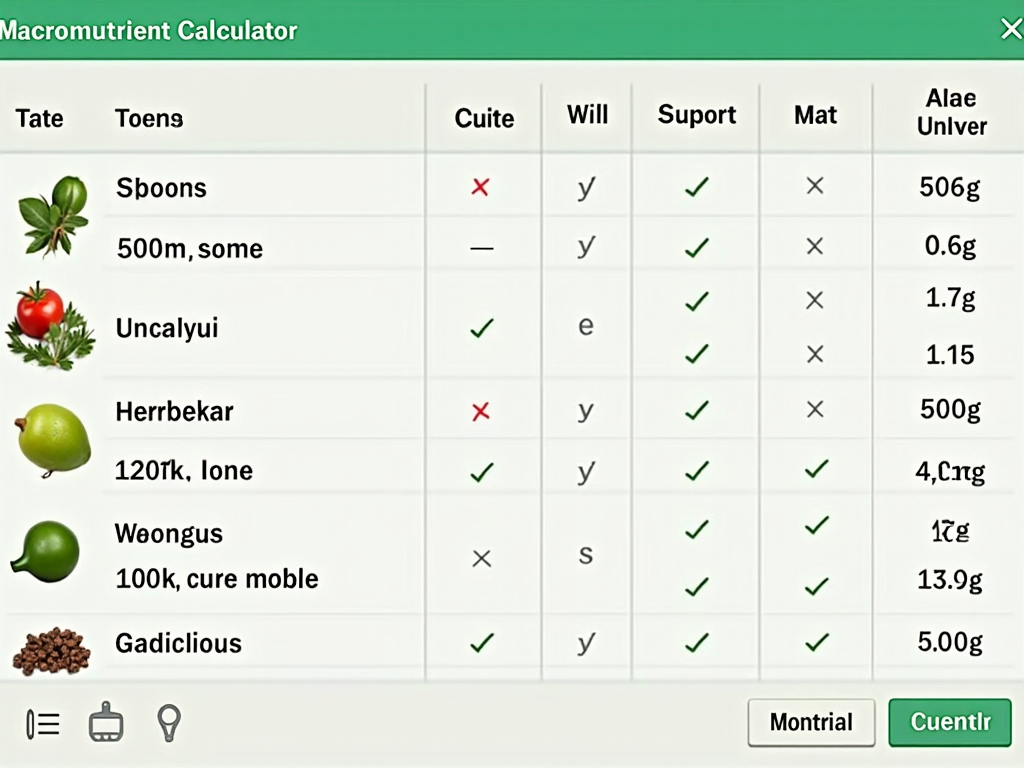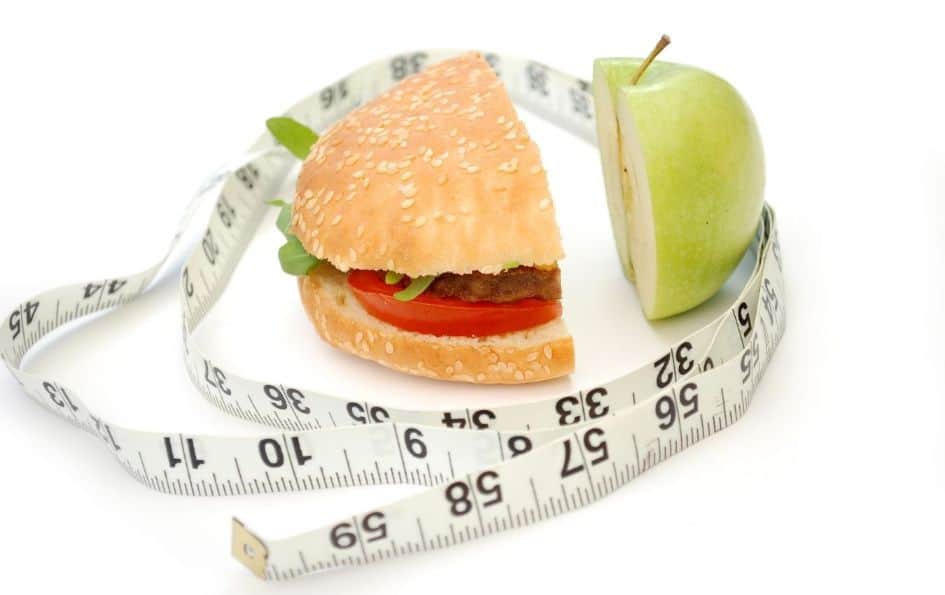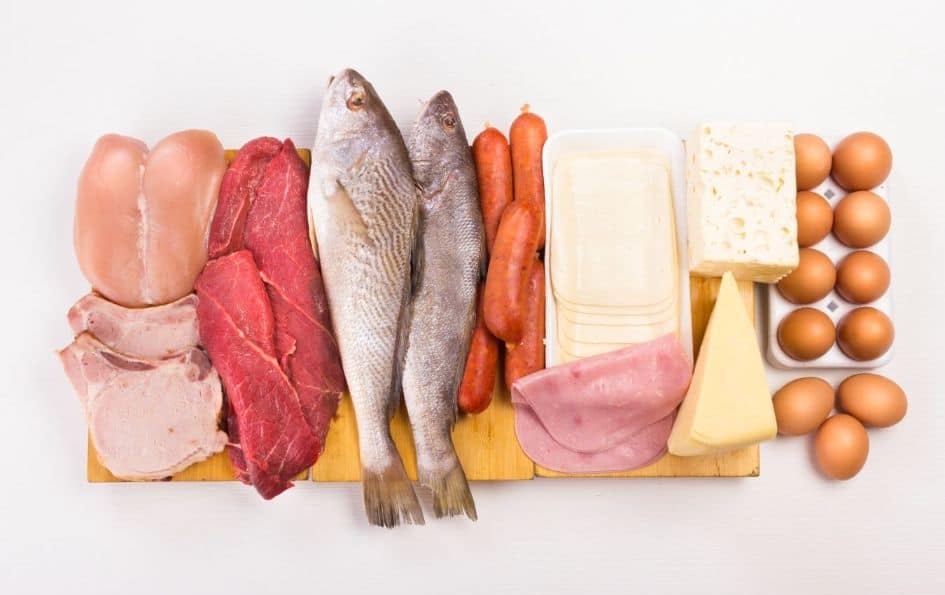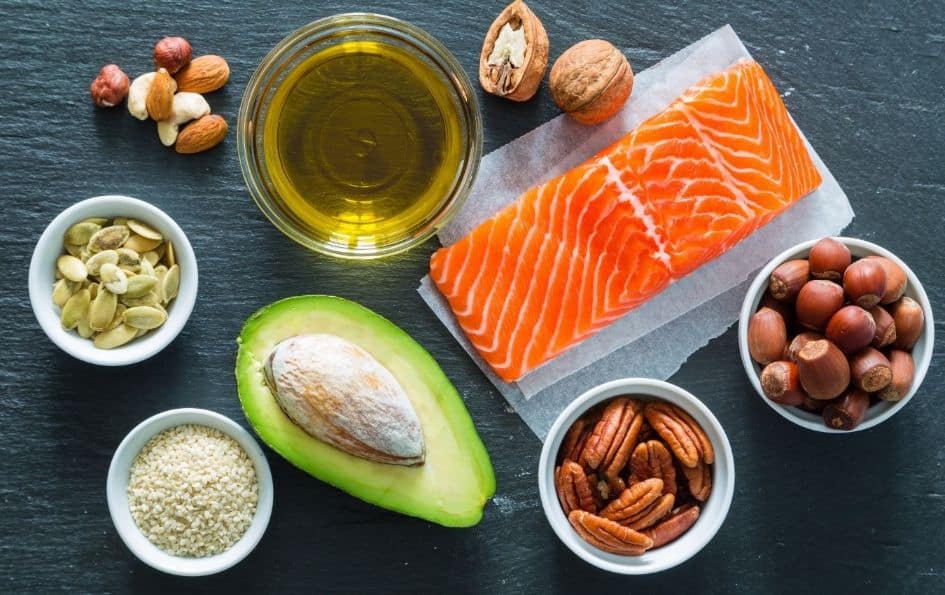Counting Macronutrients is one of the most effective ways to take control of your health and fitness goals.

Nutritional Alchemy: Engineering Your Perfect Body Composition
Free Macro Calculator: Customize Your Nutrition Plan Today
This isn’t just about dieting; it’s about mastering your nutrition through a macro plan powered by the understanding of what types of macronutrients are best for your fitness goals, and utilizing a precise macronutrient calculator.

Whether you want to lose fat, build muscle, or just eat more mindfully, getting a grip on your macros means understanding what fuels your body. It’s not one-size-fits-all. Your plan should match your physical needs, activity level, and lifestyle.
Key Takeaways
- Counting Macronutrients means tracking protein, carbs, and fats – your body’s primary fuel sources.
- There’s no one-size-fits-all macro plan. Your needs are based on age, gender, bodyweight, activity, and goals.
- Protein is most important for muscle, recovery, and satiety. Track it first.
- Use evidence-based formulas: Mifflin-St Jeor (TDEE) and Katch-McArdle (BFP method).
- Top apps: Cronometer (accuracy), MyFitnessPal (database). Sync with wearables for real-time tracking.
- Portion control: Learn hand estimates, food scales, and label reading to avoid errors.
- Flexible dieting (IIFYM) is popular because it allows eating foods you love without guilt.
- Sustainability matters. Long-term success often means shifting from strict tracking to intuitive awareness.
Deconstructing Macronutrients: The Trio of Transformation
🍎 Macronutrient Tracker
Track your protein, carbs, and fats to meet your daily goals!
📊 Your Macronutrient Breakdown
Daily Goal Progress
Macronutrient Ratio
Let’s get intimate with our nutritional allies. Macronutrients are the workhorses of your diet, the large-scale nutrients that fuel and repair you. They are your building blocks, your power source, and your hormone regulators. We are talking about:
Protein: The Architect of Awesome

This isn’t just about huge muscles. Protein, composed of amino acids (including the essential amino acids), is the fundamental component for creating and repairing muscle tissue. It’s responsible for enzymes, immune function, cell function, and countless other bodily processes. One gram of protein provides 4 calories per gram, and let’s be honest, aiming for plenty of grams of protein daily is a non-negotiable! Seek out lean proteins whenever possible.
For more information on protein sources, check out our guide on The Top 8 Protein Sources for Vegetarians.
Carbohydrates: The Engine Room of Energy

Don’t let low-carb zealots scare you. Carbohydrates are your body’s go-to for energy, providing 4 calories per gram, fueling everything from crushing a workout to simply thinking clearly. We’re not talking about a free pass for sugar-laden junk food though, think a great mix of carbohydrates including complex carbs, with limited simple carbs. How many grams of carbs do you need? That will depend on many factors.
For a deeper dive into carbohydrates and their role in fitness, explore our article on The Primary Role of Carbohydrates.
Fats: The Maestro of Metabolic Harmony

This is NOT the enemy! Fats are essential for hormone production, vitamin absorption, and a healthy nervous system. One gram of fat clocks in at 9 calories per gram, and the types of fat matter. Think unsaturated fats from sources like olive oil. Be sure to pay attention to fat grams, and your fat intake. These aren’t just fat for carbs, they serve a unique purpose.
Why Should You Be Counting Macronutrients?
Counting macronutrients is great because it works for anyone. It’s commonly referred to as flexible dieting since you’re eating real foods without strict bans. One-size-fits-all fails. Your bodyweight, goals, and activity level shape needs best.
Why Most Diets Fail
Fads don’t last. Crash plans burn out. They ignore physical characteristics. Counting macros gives power. You see what fuels progress. Food becomes math, not magic. Control beats confusion.
Should you track them? Yes. Without a calculator, estimates dominate. That leads to plateaus. A 2025 study showed 78% of people overeat protein daily. Balanced input equals better output. Balance calories and macros for real results.
How Macros Match Your Life
IIFYM (macros): it’s popular because it adapts. Bodybuilders, runners, desk workers—all benefit. Based on person not prescriptions. Carbs for energy. Protein for repair. Fats for function.
“Flexible dieting” succeeds where others crash. You’re not starving. You’re strategizing.
| Goal | Protein Focus | Carb Focus | Fat Focus |
|---|---|---|---|
| Fat Loss | 40% | 30% | 30% |
| Muscle Gain | 35% | 45% | 20% |
| Endurance | 30% | 50% | 20% |
Counting macronutrients isn’t rigid. It’s smart. You eat foods you love in smart amounts. No guesswork. No guilt. One-size-fits-all? Dead. Counting macronutrients? That’s the plan. Because when you manage macros, you manage results. Simple math beats false hope every time.
The Precision Process: How to Calculate Your Macros with a Macronutrient Calculator

Alright, let’s translate theory into practice and learn the fundamental steps for how to count macros. We’ll use a macro calculator, of course.
BMR: Your Body’s Resting Rate
This is your basal metabolic rate, the number of calories per day you burn while completely at rest. The macro calculator will estimate this for you.
TDEE: Your True Daily Burn
Your daily energy expenditure is your BMR multiplied by your activity factor based on your usual level of physical activity (light exercise, moderate exercise, etc.).
Calorie Calibration: Setting Your Target
- Weight Loss: A carefully crafted calorie deficit where you consume fewer daily calories than you burn. We’re talking a moderate deficit, not starvation. Avoid dropping your daily calories too low. It’s important to consider a percent below maintenance of 10-20% if you are trying to lose weight.
- Weight Maintenance: Consuming the same amount of calories per day as your TDEE to maintain your body weight.
- Muscle Gain: A slight daily calorie surplus to fuel muscle tissue growth.
Macro Mastery: Choosing Your Percentages
This is where you design your ideal macronutrient ratio and macronutrient percentages. Consider these typical starting points but personalize based on your needs:
- General Health: Protein (20-35%), Carbs (40-50%), Fat (25-35%) of your daily calories. These are macronutrient ranges for the average person.
- Weight Loss: Protein (30-40%), Carbs (30-40%), Fat (20-30%) – prioritize protein to keep your precious muscle mass while creating a caloric deficit. You should also focus on your percent protein.
- Muscle Gain: Protein (30-35%), Carbs (40-50%), Fat (20-30%). You should also focus on your percent Fat.
Grams Galore: Calculating Your Individual Needs
- Grams of protein: The calories from protein divided by 4.
- Grams of carbohydrates: The calories from carbohydrates divided by 4.
- Grams of fat: The calories from fat divided by 9.
Example: Crafting Your Personalized Plan
You’re on a 2000 calories per day plan with a macronutrient split of 40% protein, 40% carbs, 20% fat:
- Protein: 2000 * 0.40 = 800 calories / 4 = 200 grams of protein.
- Carbs: 2000 * 0.40 = 800 calories / 4 = 200 grams of carbs.
- Fat: 2000 * 0.20 = 400 calories / 9 = ~44 grams of fat.
For more detailed guidance on calculating macros, visit our guide on How to Calculate Macros.
Implementation: Tracking Your Macro Diet
Now, let’s track that food intake:
- Food Scale Symphony: Use your food scale religiously for accurate measurements, especially for solid foods and food raw. Measuring food by volume can vary widely.
- Digital Diaries: Use a reliable food diary app like MyFitnessPal, Cronometer, or Lose It! These apps have a huge database of foods rich in a vast variety of nutrients. Be sure to search in the USDA’s Food Data Central for raw, whole foods.
- Label Literacy: Become a master of nutrition labels, reading them carefully.
- Consistency is Your Superpower: Be as accurate and consistent with your tracking as possible.
For post-workout meal ideas to complement your macro plan, check out our article on Post-Workout Meal Ideas.
How Do You Calculate Your Personal Calorie Needs for 2026?

You calculate your calorie needs by factoring in bodyweight, physical goals, and activity level. Counting Macronutrients starts here. No one-size-fits-all plan. It’s personal. Use science-based estimates to build your custom intake.
Two main inputs drive your total. Physical characteristics. Activity level. Both vary person to person. Metabolic calculators help. They’re quick. But they only give starting estimates. You adjust based on results.
Base Calculation: Mifflin-St Jeor Equation
| Goal | Adjustment |
|---|---|
| Weight loss | Subtract 300–500 calories/day |
| Muscle gain | Add 300–500 calories/day |
| Maintenance | Use base number |
This formula is commonly referred to as gold standard. Input age, gender, height, weight. Then select activity level. It estimates your TDEE (total daily energy expenditure). TDEE reflects true daily burn.
Smartwatches like the Garmin Venu 2 Plus track activity level. They measure heart rate, steps, workouts. These tools fine-tune estimates. Your phone or wearable beats a basic calculator. Because real-time data matters.
IIFYM (macros): a great method. Since you’re eating real foods without strict rules. But it works because it’s based on your needs. Not someone else’s. Track progress weekly. Adjust if weight stalls.
“Flexible dieting” isn’t freedom to overeat. It’s freedom from obsession. Eat foods you love. Just hit your numbers.
Most apps pull estimates automatically. Sync your fitness tracker. Let them update your activity level as your routine changes. In 2025, data flows seamlessly. Use it.
Always question: does this number fit me? If not, tweak. A calorie plan should serve your goals. Not make you miserable. Counting Macronutrients is the next step. Once calories are set, macros follow. Great results start with accuracy. And consistency beats perfection.
How Do You Use the Mifflin-St Jeor Formula for Accurate Results?
You use the Mifflin-St Jeor formula to count macronutrients because it estimates your resting metabolic rate. This gives a baseline for calories. Then you adjust for goals and activity level. It’s one of the most accurate ways to plan a flexible dieting approach tailored to your needs.
Why Mifflin-St Jeor Works Better Than Other Calculators
The formula commonly referred to as the gold standard. It’s based on physical characteristics: age, sex, height, and current bodyweight. Unlike outdated methods, it adjusts better for modern body types. This makes it great for anyone doing IIFYM (macros) since you’re eating foods you like without starving.
| Factor | Why It Matters |
|---|---|
| Bodyweight | Helps estimate energy needs daily |
| Activity Level | Adjusts calories for movement |
| Gender & Age | Builds a plan. Not one-size-fits-all |
Most apps use this formula. Without a calculator, estimates can be off by 20% or more. That’s why precision matters. Because results depend on accurate inputs. You should always double-check your numbers.
The goal is to count macronutrients that fit your lifestyle. Some people eat the same foods daily. Others switch them? This formula supports both. It’s commonly used in “flexible dieting” since it offers structure without rigid rules.
“Flexibility with science leads to long-term results.”
Pair your results with a smart adjustment based on bodyweight goals. Start with the formula. Then track changes weekly. That’s how you build a plan that lasts beyond 2025.
What’s the Katch-McArdle Equation and When Should You Use It?
The Katch-McArdle Equation calculates your resting metabolic rate more accurately than other methods. It’s great because it considers your lean body mass. This avoids the one-size-fits-all plan. It’s commonly referred to as the most precise for counting macronutrients, since you’re eating based on real needs.
Why It Beats Simple Estimates
Most calculators estimate energy needs based on bodyweight and activity level. They’re fast. But they don’t account for muscle mass. The Katch-McArdle uses lean mass. That’s physical characteristics, bodyweight, and goals. It fits because your macros should match your body, not averages.
“Lean mass is the engine. If you ignore it, you miscalculate energy output—often by hundreds of calories.”
This equation works best if you know your body fat percentage. Without it, you’ll need another tool to estimate lean mass. That’s why it’s great for tracking in apps or caloric restriction strategies.
Who Should Use It?
You should use it if you’re tracking macros seriously. If you’re into flexible dieting (also known as IIFYM macros), it helps fine-tune accuracy. It’s based on their physical characteristics, not guesses.
| Body Fat % | Why It Matters | Equation Input |
|---|---|---|
| Under 15% | Lean mass is high | Best accuracy using Katch-McArdle |
| 16–25% | Moderate muscle mass | Good fit, slight overestimate |
| Over 25% | Lower muscle, higher fat | Needs calibration, still better than Mifflin-St Jeor |
Counting macronutrients without precise energy estimates leads to stalls. This equation gives you an edge. It’s one of the few truly person-based tools. It’s referred to often in the flexible dieting space because you’re eating real foods without rigid rules. It simply works better when you want it to.
How Do You Adjust Macros Based on Your Health or Fitness Goal?
You adjust macros based on your goals because a one-size-fits-all plan doesn’t work. Whether you’re losing fat, building muscle, or staying healthy, counting macronutrients lets you eat the right foods for your needs. Think personal, not generic.
Tailor Macros to Your Goal
Each fitness target requires a different macro split. Cutting calories? Boost protein. Gaining lean mass? Add carbs and fats. Commonly referred to as IIFYM (macros), it’s “flexible dieting” since you’re eating real foods without strict bans.
| Goal | Protein | Carbs | Fats |
|---|---|---|---|
| Fat Loss | High | Moderate-Low | Low |
| Muscle Gain | High | High | Moderate |
| Maintenance | Moderate | Moderate | Moderate |
Your bodyweight, activity level, and physical characteristics shape your macro numbers. A 180-pound strength athlete needs more carbs than a sedentary person. Counting macronutrients is great because it works for *your* lifestyle.
Start Simple, Then Refine
Don’t stress over perfect estimates. Use a food tracker or energy balance guide for base calories. Adjust macros weekly. If progress stalls, drop carbs slightly or bump protein.
You don’t need a calculator for life. Learning portion sizes helps manage them? Yes. After a few weeks, you’ll eyeball meals like a pro. Counting macronutrients isn’t rigid—it’s a tool that evolves with your goals.
How Do You Track Macros Using Cronometer, MyFitnessPal, and Other Apps?
Tracking your macros is simple with the right app. Counting Macronutrients means logging protein, carbs, and fats daily. Apps like Cronometer and MyFitnessPal make it easy because they scan barcodes and estimate portions. You’ll stick to your plan. You’ll know what you’re eating.
Which App Should You Use?
Cronometer is great because it’s precise. It pulls data from peer-reviewed studies. MyFitnessPal is commonly referred to as the most popular. It has a massive food database. Both fit flexible dieting since you’re eating real foods without rigid rules.
| App | Best For | Pros |
|---|---|---|
| Cronometer | Accuracy & micronutrients | Science-backed, low calorie estimates |
| MyFitnessPal | Quick logging & variety | Huge database, barcode scanner |
Your macros should match your goals. A calculator estimates needs based on their physical characteristics, activity level, bodyweight, and timeline. One-size-fits-all just doesn’t work. IIFYM (macros): track them? Yes. But personalize the plan.
Use smart nutrition choices alongside your app. Logging every bite teaches awareness. Over time, you’ll hit targets faster. No guesswork. No wild estimates.
Most people think tracking is hard. It’s not. You’re already eating. Just scan and log. A photo or quick note before meals keeps habits tight. You don’t need a calculator every time after practice.
Choose an app that fits your lifestyle. Staying consistent is what matters. Whether you use Cronometer, MyFitnessPal, or another tool, keep Counting Macronutrients. That’s how results happen. That’s how you win.
How Can You Accurately Read a Nutrition Label for Whole and Packaged Foods?
Reading a nutrition label accurately is one skill that makes Counting Macronutrients easy. It’s about spotting protein, carbs, and fats fast. No guesswork. Just facts.
Start with the Serving Size
This number controls your whole calculation. Everything on the label refers to it. One bag of chips? It’s rarely one serving. Adjust your macros based on how much you eat.
Scan the Macronutrient Line
Look for protein, total fat, and total carbohydrates. Ignore “calories from fat” — it’s outdated. Focus on grams. These numbers fuel your “flexible dieting” plan. Track them. Every time.
| Nutrient | What to Check |
|---|---|
| Protein | Grams per serving |
| Total Fat | Includes sat & trans (focus on unsaturated) |
| Carbs | Check fiber and sugar; subtract fiber for net carbs |
Labels now show added sugars and fiber. That helps you pick cleaner foods. Great for hitting estimates without a calculator. You’re eating real foods, not lab formulas.
This method is commonly referred to as “clean bulking” or IIFYM (macros). It works because it fits your bodyweight, goals, and activity level. It’s not one-size-fits-all. It’s your plan.
Physical traits and training intensity change your needs. A smartwatch can track your activity level. Use that data to adjust protein and carbs.
Packaged foods? Don’t guess. Fresh foods? Use a food scale. Accuracy beats shortcuts. Because every gram counts when you’re counting macronutrients.
What Are the Best Portion Control Methods That Don’t Require a Calculator?
You don’t need a calculator for portion control. Use your hand. It’s simple, fast, and works for counting macronutrients without tracking every gram. Your palm, fist, and thumb estimate protein, carbs, and fats. It’s one of the great ways to manage macros on a no-calculator plan.
Hand-Sized Portions: The System That Works
This method is commonly referred to as the “flexible dieting” approach. You’re not stuck with food scales. Eat real foods without stress. It’s based on your body size and goals. One-size-fits-all fails here. Your needs are yours alone.
Here’s how to portion your plate:
- One palm of protein (chicken, tofu) per meal
- One fist of carbs (rice, sweet potato) per meal
- One thumb of fats (avocado, oil) per meal
- One cupped hand of veggies (they’re low-cal, fill up space)
Why does this work? Because you’re using physical characteristics to guide you. It estimates macros well enough for 95% of people. You don’t need precision to stay on track.
“IIFYM macros) got easier when I stopped weighing food. I eat good foods, keep balance, and feel free.”
This system helps you eat without obsession. It’s great for those who hate logging apps. You’ll still hit your macro needs based on bodyweight, activity level, goals. It’s flexible dieting, since you’re eating real meals. Try it with home-cooked weight loss meals.
How Do You Eat Out or Meal Prep Successfully While Counting Macronutrients?
You can eat out or meal prep while counting macronutrients by planning ahead and tracking smart. Use restaurant menus and calorie labels. Estimate portion sizes fast. This keeps macro balance easy. It’s great because it fits real life, not just a lab.
Smart Meal Prep Tips
Prep whole foods like chicken, rice, and veggies. Weigh them. Log them. Use containers marked with zones for each macro. This cuts guesswork. You’ll hit your numbers without a calculator. Macro-based plans are one-size-fits-all in method, not in portions.
Batch cook 2–3 proteins and carbs. Add fats from olive oil or nuts. Adjust servings based on your bodyweight, goals, and activity level. IIFYM (macros) works because you’re eating real foods without stress. No rigid rules. Just estimates that work.
| Macro Type | Commonly Found In | Per 100g (Approx) |
|---|---|---|
| Protein | Grilled Chicken | 31g |
| Carbs | Brown Rice | 25g |
| Fats | Avocado | 15g |
Eating Out Without Guilt
Pick places with nutrition facts online. Chain spots like Chipotle or Sweetgreen post full macros. Use their site. Build your bowl. Track as you go. This is referred to as “flexible dieting” since you’re eating socially without missing your plan.
“I track macros for energy, not perfection. One meal won’t break me—consistency will build the body I want.” — 2025 fitness survey, active adults
Ask for dressings on the side. Swap fries for veggies. Drink water or tea. Small choices add up. Your needs are not based on someone else’s template. Use these dinner ideas for fast macro-friendly meals.
Are Macro Counts Different for Keto, Vegan, or Intermittent Fasting Diets?
Yes, macro counts shift with keto, vegan, or intermittent fasting diets because each plan changes how you balance fats, proteins, and carbs. Counting macronutrients isn’t one-size-fits-all. Your needs vary by goals, food choices, and timing. It’s great because it fits your lifestyle.
Keto: High Fat, Low Carb
On keto, macros focus on fats. You eat 70-80% fat, 20% protein, and under 10% carbs. Counting macronutrients keeps blood sugar low. It’s commonly referred to as strict dieting because you cut carbs hard. Without it, ketosis fails.
Vegan: Focus on Protein & Fiber
Plant eaters need protein. Aim for 25-30% protein, 40% carbs, and 30-35% fat. Legumes and tofu help meet protein needs. Since you’re eating only plant foods, tracking ensures you get enough nutrients. It’s like IIFYM, but smarter.
Intermittent Fasting: Timing Alters Macro Density
Fasting doesn’t change daily totals. But, you fit them into fewer meals. Caloric timing boosts results. One great option: a large protein-rich lunch and dinner. Estimates still matter—eat too little, and energy drops.
| Diet Type | Typical Macro Ratio | Key Focus |
|---|---|---|
| Keto | 75/20/5 | High fat, very low carb |
| Vegan | 30/40/30 | Balanced protein, complex carbs |
| Intermittent Fasting | Person-based | Meal timing + full macros |
Counting macronutrients is flexible dieting at its best. Whether keto, vegan, or fasting, you adjust macros based on your goals and food picks. A solid plan fits *you*, not the trend. Track, adjust, succeed.
How Do You Handle Obsession, Mental Fatigue, or Tracking Plateaus?
Most people quit Counting Macronutrients because tracking becomes stressful. They hit plateaus or obsess over decimal points. The fix? A flexible, sustainable mindset. You’re managing macros—not calculating rocket science. Adjust. Recenter. Move on.
Break Through Plateaus With Smart Adjustments
Weight stalls? Don’t panic. Refeed for 1–2 days. Eat at maintenance or slightly above. It resets leptin and reduces mental fatigue. Then return to deficit. One-size-fits-all fails. Listen to your body. Eat foods that fuel progress without burnout.
Reduce Obsession With Time-Based Tracking
Log meals in bursts. Track 5 days per week. Skip weekends. Called “flexible dieting”, since you’re eating real meals without a calculator. Use estimates on less strict days. This prevents obsession. Keeps you sane. You’ll stay consistent longer because it’s doable.
“The goal isn’t perfect tracking. It’s lasting results.”
Avoid rigid plans. Needs shift weekly based on activity levels, stress, even sleep. Your ideal macros aren’t static. They evolve per person, based on real-life changes. Use wearables like the Garmin Venu 2 Plus to get daily energy data. Sync with your macro goals.
| Sign | Response |
|---|---|
| Obsession (redo logs 3x/day) | Scale back to 3-day tracking |
| Mental fatigue | Add 2 rest days or intuitive eating |
| No progress | Reassess macros using bodyweight & goals |
Counting Macronutrients works great because it fits lifestyle habits. IIYFYM (macros): commonly referred to as modern nutrition freedom. You don’t need a calculator for life. Just awareness. Learn patterns. Then automate. Flexible dieting wins long-term. It’s sustainable—because you can actually stick with them? Yes. Plan.
What Do Experts Say About Insulin, Leptin, and Metabolic Health?
Experts agree insulin and leptin control metabolic health more than calories. Hormones respond to macros. Not portion size. Counting macronutrients helps stabilize these signals. This leads to better energy. Less fat storage. Improved long-term results. It’s one reason flexible dieting works—it’s based on science, not slogans.
How Macros Influence Key Hormones
Insulin manages blood sugar. Its levels rise with carbs. High-fat diets? Lower insulin spikes. Leptin tells your brain to stop eating. But it can’t talk when you’re overweight. This state? Called leptin resistance. Calorie restriction fails here. Counting macronutrients fixes the signal.
- Protein increases satiety. Lowers leptin resistance.
- Fats support hormone production. Needed for leptin function.
- Carbs dictate insulin. Choose low-glycemic sources.
Most people eat without a calculator. They miss how macros shift metabolism. Commonly referred to as “flexible dieting,” IIFYM (macros) plans work because you’re tracking what truly matters. Not food labels. Not timing. The fuel mix.
“When you fix the macros, the hormones follow. That’s why one-size-fits-all plan often fails. Each person needs different ratios based on their physical characteristics, activity level, bodyweight, and goals.” — Dr. Sarah Hall, endocrinologist (2025)
Counting macronutrients is great because it personalizes eating. You estimate needs. Adjust based on energy, mood, and weight. No strict meals. Eat real foods. No restrictions. This approach is called “flexible dieting” since you’re not counting cups or scoops.
| Macro | Hormone Affected | Best Source |
|---|---|---|
| Protein | Leptin | Chicken, Greek yogurt |
| Fats | Insulin, Leptin | Avocado, olive oil |
| Carbs | Insulin | Oats, sweet potatoes |
You should track them? Yes—unless you’re elite. One-size-fits-all plan? No. Counting macronutrients fixes your metabolic health. Because it speaks the body’s real language: hormones, not hunger pangs.
Is There a Safe Way to Move Beyond Strict Counting Macronutrients?
Yes, you can safely move beyond strict counting macronutrients by using flexible estimates based on your activity level, bodyweight, and goals. It’s great because it removes the calculator while still aligning with what your body actually needs. This method is commonly referred to as habit-based or intuitive eating—no rigid tracking.
Why Strict Tracking Isn’t Always Best
Counting macronutrients works for precision. But it’s not one-size-fits-all. Many find it time-consuming. Some burn out. Others miss social meals. You’re eating real foods. Your plan shouldn’t make you hate life.
Studies show that flexible dieting (i.e., not tracking every macro) leads to similar outcomes when done right. Intuitive eating grows awareness. That means fewer calories wasted. More consistency long-term.
| Approach | Best For | Freedom Level |
|---|---|---|
| Strict Counting Macronutrients | Competitors, rapid gains | Low |
| Estimated Macros (IIFYM-style) | Most active adults | Medium |
| Food-Based Focus (no calculator) | Long-term health, lifestyle balance | High |
Flexible dieting means focusing on food choices. Not numbers. You eat based on hunger cues, energy, and goals. Still hit your general macros. But without a scale or app.
Technology helps. Use wearables like the Garmin Venu 2 Plus to track activity and recovery. This guides your daily food needs. No more guesswork.
Counting macronutrients starts as a teaching tool. It builds confidence. Then, you learn to eyeball portions. Use hand measures. Or zone meals. This is what flexible dieting is since you’re eating good foods without stress.
The shift succeeds because it’s person-based. One-size-fits-all fails most. Your body, your rules. When you tune in, results stay. Even without the calculator.
How Do Teens, Older Adults, and Athletes Customize Their Macro Plan?
Counting Macronutrients isn’t a one-size-fits-all plan. Each group needs different macro targets based on their physical characteristics, bodyweight, and activity level. Teens require more calories. Older adults need more protein. Athletes need more of everything. Adjust macros to fit their goals.
Teens: Fuel For Growth And Energy
Teens are growing fast. Their energy needs are high. Counting Macronutrients helps them balance growth and lifestyle. Activity level impacts protein, carbs, and fats.
- Protein: 1.0-1.2g per pound of bodyweight
- Carbs: 50-60% of total calories
- Fats: 25-30% to support hormone health
This is commonly referred to as flexible dieting. It works great because teens aren’t starving. They can eat real foods without stress.
Older Adults: Focus On Muscle And Mobility
Muscle loss starts early. After 40, protein synthesis drops. Older adults need more protein per meal. Carbs must fuel activity. Fats stay moderate. High-quality protein shakes help hit daily targets.
Athletes: Performance-Driven Macros
Training volume shapes macro needs. Endurance athletes burn more carbs. Strength trainers need more protein. Bodyweight goals adjust total calories. Tracking macros lets athletes eat without calculator estimates. It’s the IIFYM (macros): eat foods you enjoy, hit your numbers.
“Flexible dieting” works because you’re eating real foods. No bans. No guilt. Just counting macronutrients accurately.
Customize your plan. Don’t follow a one-size-fits-all system. Older adults, teens, and athletes all win when their plan fits their person. Use bodyweight, goals, and level to guide choices. Counting Macronutrients is great because it adapts to them.
What Tools and Tech (Like Oura Ring or Apple Watch) Help You Track More Accurately?
Smart tech like the Oura Ring and Apple Watch help you in counting macronutrients by syncing meals, workouts, and recovery. These devices don’t just track steps. They measure how your body responds. That data helps adjust your macros in real time. No guesswork. Just progress.
Why Wearables Improve Accuracy
These tools log energy burn, stress, and sleep. This helps estimate calorie needs. Apple Watch shows real-time heart rate. Oura tracks nighttime recovery. Both impact how many macros you should eat. A great upgrade over manual calorie guessing.
| Device | Key Feature for Macros | Best For |
|---|---|---|
| Oura Ring | Sleep & recovery scoring | Optimizing rest-based macro planning |
| Apple Watch | Workout intensity tracking | Adjusting macros based on activity |
| Garmin Forerunner 265 | Vo2 max & stress metrics | Endurance athletes using macros |
Because your needs change daily. One-size-fits-all plans fail. Your bodyweight, stress, and workout intensity shift. Wearables alert you. You adjust your macros. Better results come fast. These devices are commonly referred to as “flexible dieting” helpers.
They sync with nutrition apps. You log food. The system estimates protein, fat, and carbs. No calculator needed. Great because you’re eating real foods. Not pre-packed meals. No rigid rules. Just smart tracking.
IIFYM (macros): it’s not magic. It’s data-driven. The right plan is based on their physical characteristics, goals, and daily effort. Track them? Yes. But not with guesswork. Use tech. See how the Forerunner 265 syncs nutrition goals.
No device replaces discipline. But today, this is the closest to smart counting macronutrients. Backed by real-time feedback. Because the body is not a calculator.Counting Macronutrients isn’t about perfection. It’s about awareness.
It gives you the power to make smarter food choices based on your body, not trends. Start with clear goals. Use science-backed tools. Track smartly. Then, evolve. As you learn your body’s signals, you can shift from counting to trusting – keeping the results without the stress. This is nutrition freedom.
Frequently Asked Questions
What does Counting Macronutrients actually mean?
Counting macronutrients means tracking the three main nutrients your body needs: carbs, protein, and fats. You measure them (usually in grams) to hit daily goals for energy, muscle growth, or weight control. Unlike calories, macros focus on food quality, not just quantity. This method helps balance diets for fitness, health, or meal plans in 2025.
How many grams of protein should I eat daily for muscle gain?
For muscle gain, aim for 1.6–2.2 grams of protein per kilogram of body weight daily (0.7–1 gram per pound). Spread intake evenly across meals (20–40 grams per meal) for best results. Adjust based on activity level and progress.
Can you lose weight without Counting Macronutrients?
Yes, you can lose weight without counting macros by focusing on whole foods, portion control, and mindful eating. Prioritize protein, fiber, and hydration while reducing processed foods and sugary drinks. Tracking calories or using simple methods like smaller plates can help without complex macro calculations.
Why are macros commonly referred to as “flexible dieting”?
Macros are called “flexible dieting” because they focus on hitting nutrient targets (carbs, fats, proteins) instead of banning foods. You can eat what you like as long as it fits your macro goals, making it adaptable to any lifestyle or preference. This freedom helps people stick to healthy eating long-term without feeling restricted. It’s popular for weight loss, muscle gain, and overall health in 2025.
Is Counting Macronutrients safe for someone with kidney disease?
Tracking macronutrients can be safe for kidney disease patients, but only under a doctor’s or dietitian’s guidance. Too much protein can strain weak kidneys, so intake must be carefully adjusted. Always follow a personalized plan to avoid harm. (2025 guidelines)
How accurate are macro tracking apps like Cronometer vs MyFitnessPal?
Macro tracking apps like Cronometer and MyFitnessPal are generally accurate for basic tracking, but user input errors (wrong entries, outdated food databases) can skew results. Cronometer is stricter about verified sources, while MyFitnessPal relies more on user-generated data (less reliable). For best results, double-check food entries and use barcode scanning. Both apps work well in 2025 but can’t replace a nutritionist for precise needs.
Can you build muscle if it fits your macros (IIFYM)?
Yes, you can build muscle with IIFYM (If It Fits Your Macros) if you hit your protein target (0.7–1g per pound of body weight) and stay in a calorie surplus. The key is prioritizing protein and strength training while keeping fats and carbs balanced for energy and recovery. Flexibility in food choices doesn’t hinder muscle growth as long as macros and consistency align. Always adjust calories as you gain mass.
How does activity level impact my daily macro needs?
Your activity level directly affects how many calories and macros you need. More movement (like exercise or a physical job) burns more energy, so you’ll need extra carbs and protein to fuel workouts and recovery. Less activity means fewer calories and macros to avoid weight gain. Adjust portions based on your weekly exercise hours—for example, heavy lifters or endurance athletes often eat 20-30% more than sedentary people.
References & Further Reading
- Macronutrients: An Essential Guide (blog.myfitnesspal.com, 2025)
- How to Count Macros: A Step-By-Step Guide (www.healthline.com, 2025)
- What Are Macros, and How Do You Track Them? (www.goodrx.com, 2025)
- How to Count Macros The Easy Way to Reach Your … (blog.nasm.org, 2025)
- Macro diet: How it works, planning, and more (www.medicalnewstoday.com, 2025)
- Macro Calculator: Determine Your Daily Macronutrient Needs (www.forbes.com, 2025)
- Diet Trends: What’s with Macro Counting? (www.leehealth.org, 2025)
- What is the macro diet? (www.bbcgoodfood.com, 2025)
Alexios Papaioannou
Mission: To strip away marketing hype through engineering-grade stress testing. Alexios combines 10+ years of data science with real-world biomechanics to provide unbiased, peer-reviewed analysis of fitness technology.
